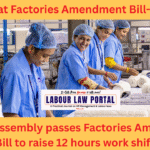Karnataka High Court Broadens ESI Applicability to Contract Labourers
Pivotal Judgment Establishes Employer Liability for Engaging Contract Workers in Construction, Repair, and Maintenance Activities
In a significant judgment that could reshape employer obligations across India’s industrial landscape, the Karnataka High Court has ruled that contract labourers engaged within factory premises—whether for construction, repairs, or maintenance—qualify as “employees” under Section 2(9) of the Employees’ State Insurance Act, 1948 (ESI Act). This ruling affirms that principal employers are liable to pay ESI contributions for such workers, even if they are hired through third-party contractors.
The decision, delivered earlier this month, overturns a previous order by the Employees’ State Insurance (ESI) Court, which had substantially reduced the contribution demand on the grounds that the workers were not under the direct control of the company. The High Court’s ruling restores the original demand of ₹13,52,825, reinforcing the expansive and welfare-oriented interpretation of the ESI Act.
Background of the Case
The dispute arose when a manufacturing company engaged contractors to undertake various infrastructure-related tasks within its factory premises. These included building sheds, installing operational units, and renovating existing structures—activities that were ongoing and essential to the factory’s functioning.
Despite the regular nature of the work and the presence of contract labourers on-site, the company did not remit ESI contributions for these workers. The Employees’ State Insurance Corporation (ESIC) initiated proceedings, demanding payment of ₹13.5 lakh in contributions. The company contested the demand, arguing that the workers were not its direct employees and therefore not covered under the ESI Act.
The ESI Court partially accepted the company’s argument, reducing the liability to ₹3.5 lakh. It held that since the workers were under the control of the contractors and not the principal employer, the company was not fully liable under the Act.
High Court’s Interpretation: Expanding the Definition of “Employee”
The Karnataka High Court, in its detailed judgment, rejected the narrow interpretation adopted by the ESI Court. The bench emphasized that Section 2(9) of the ESI Act defines “employee” in broad terms, encompassing not only direct employees but also those hired through contractors, provided their work is connected to the factory’s operations.
“The nature of the work—construction, repairs, and maintenance—forms an integral part of the factory’s functioning. It cannot be termed as non-core or incidental,” the Court observed.
The judgment clarified that the test of “direct control” is not determinative in assessing ESI liability. Instead, the focus must be on the nature of the work and its connection to the factory’s operations. If the work is essential to the functioning of the establishment, the workers performing it—regardless of their contractual status—are entitled to ESI coverage.
Welfare Orientation of the ESI Act
The Court underscored the welfare-centric nature of the ESI Act, which was enacted to provide social security to workers in the organized sector. It reiterated that the legislation must be interpreted in a manner that furthers its protective objectives.
“The ESI Act is a piece of beneficial legislation. Its provisions must be construed liberally to ensure that workers engaged in factory operations are not denied coverage merely due to the mode of employment,” the bench stated.
By restoring the full demand of ₹13,52,825, the Court sent a clear message that principal employers cannot evade statutory obligations by outsourcing core functions to contractors. The ruling aligns with the Supreme Court’s jurisprudence on social welfare laws, which consistently favors expansive interpretations to safeguard worker rights.
Implications for Industry and Compliance
This ruling has far-reaching implications for employers, particularly in sectors like manufacturing, construction, and logistics, where contract labour is prevalent. Companies will now need to reassess their compliance frameworks to ensure that all workers engaged in factory-related activities—regardless of employment modality—are covered under the ESI scheme.
Legal experts suggest that the judgment could trigger a wave of audits and enforcement actions by ESIC, especially in cases where companies have historically excluded contract labour from ESI contributions.
“This decision reinforces the principle that statutory obligations cannot be outsourced. Employers must take proactive steps to identify all workers engaged in factory operations and ensure their inclusion under ESI,” said Advocate R. Krishnamurthy, a Bengaluru-based labour law specialist.
Revisiting the Role of Contractors
The judgment also raises questions about the role and responsibilities of contractors in the ESI framework. While contractors are required to register and contribute for their employees, the principal employer remains ultimately liable under Section 2(9) and Section 40 of the ESI Act.
The High Court’s ruling reiterates that the principal employer cannot escape liability by citing the contractor’s failure to comply. In fact, the Act explicitly provides that the principal employer must ensure compliance and can recover the amount from the contractor if necessary.
This dual liability structure is designed to prevent gaps in coverage and ensure that workers are not left vulnerable due to contractual arrangements.
Legal Precedents and Comparative Jurisprudence
The Karnataka High Court’s decision is consistent with earlier rulings by the Supreme Court and various High Courts, which have held that the definition of “employee” under the ESI Act is inclusive and must be interpreted in light of the Act’s welfare objectives.
In ESIC v. Harrison Malayalam Ltd. (2003), the Supreme Court held that even temporary and casual workers engaged in activities connected to the factory are entitled to ESI benefits. Similarly, in CESC Ltd. v. Subhash Chandra Bose (1992), the apex court emphasized that the nature of work and its connection to the establishment are key determinants of coverage.
The Karnataka High Court’s ruling builds on this jurisprudence, extending it to contract labour engaged in infrastructure-related tasks within factory premises.
Compliance Advisory for Employers
In light of this judgment, legal and HR teams across industries should consider the following steps:
- Audit Workforce Composition: Identify all contract labourers engaged in factory operations, including those hired for construction, maintenance, and repairs.
- Review Contractor Agreements: Ensure that contracts explicitly address ESI compliance and indemnify the principal employer for any lapses.
- Coordinate with ESIC: Engage proactively with ESIC to clarify coverage obligations and avoid retrospective demands.
- Update Payroll Systems: Integrate contract labour into ESI contribution workflows to ensure timely and accurate payments.
- Train HR and Compliance Teams: Conduct workshops to sensitize internal teams about the expanded definition of “employee” and the implications of non-compliance.
Conclusion: A Wake-Up Call for Employers
The Karnataka High Court’s ruling serves as a wake-up call for employers who rely heavily on contract labour but have not extended statutory benefits to such workers. By reaffirming the inclusive scope of the ESI Act and emphasizing the principal employer’s responsibility, the judgment strengthens the social security net for India’s industrial workforce.
As industries evolve and employment models become more fluid, courts are increasingly prioritizing worker protection over formalistic distinctions. This decision is a testament to that trend—and a reminder that compliance must keep pace with the realities of modern labour deployment. For further insights into the evolving workplace paradigm, visit



